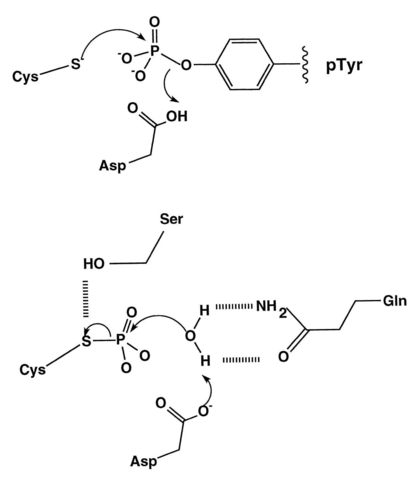Difference Between Kinase and Phosphatase
Table of Contents
Kinase vs Phosphatase
The difference between Kinase and Phosphatase stems from the fact that these two enzymes support two opposite processes. Kinase and phosphatase are two important enzymes that deal with phosphates found in biological systems. Enzymes are three-dimensional globular proteins that act as biological catalysts for many biochemical reactions in the cells. Because of this ability, the arrival of enzymes was considered as one of the most important events in the evolution of life. Enzymes increase the rate of biochemical reactions by stressing specific chemical bonds. Kinase and Phosphatase are two essential enzymes involved in the protein phosphorylation. Proteins phosphorylation facilitates key functions of proteins, including cellular metabolism, cell differentiation, signal transduction during the growth, transcription, immune response, etc. Protein phosphorylation involves the conformational changes of the protein molecules by addition of the phosphate group from ATP molecules, whereas dephosphorylation involves the removal of phosphate groups from the protein. Phosphorylation and dephosphorylation processes are catalyzed by kinase and phosphatase enzymes respectively. In this article, difference between kinase and phosphatase will be discussed by highlighting the important facts about kinase and phosphatase.
What is Kinase?
Kinases are group of enzymes that catalyze the phosphorylation reactions by the addition of phosphate groups from ATP to protein molecules. The phosphorylation reaction is unidirectional because of the massive energy release with the breakdown of phosphate-phosphate bond in ATP to produce ADP. There are many different types of protein kinases and each kinase is responsible for phosphorylating of a specific protein or set of proteins. However, when considering the amino acid structure in general, kinases can add phosphate groups to three types of amino acids, which consist of an OH group as part of their R group. These three amino acids are serine, threonine, and tyrosine. Protein kinases are categorized based on these three amino acid substrates. Serine/ threonine kinase class resembles the most cytoplasmic proteins. During the process of phosphorylation, kinase can either enhance or reduce the protein’s activity. However, the activity depends on the site of phosphorylation and the structure of the protein being phosphorylated.

Basic Phosphorylation reaction
What is Phosphatase?
The reverse reaction of phosphorylation, the dephosphorylation is catalyzed by phosphatase enzymes. During the dephosphorylation, phosphatase removes the phosphate groups from protein molecules. Hence, a protein activated by a kinase can be deactivated by a phosphatase. However, dephosphorylation reaction is not reversible. There are many different phosphatases that are found in cells. Some phosphatase is highly specific and dephosphorylates one or few proteins, whereas others remove phosphate in a broad range of proteins. Phosphates are hydrolases as they use the water molecule for dephosphorylation. Based on the substrate specificity, phosphatases can be categorized into five classes namely; tyrosine-specific phosphatases, serine/threonine specific phosphatases, dual specificity phosphatases, histidine phosphatases, and lipid phosphatases.

Mechanism of Tyrosine dephosphorylation by a CDP
What is the difference between Kinase and Phosphatase?
• Kinase enzymes catalyze phosphorylation of proteins by the addition of phosphate groups from ATP molecules. Phosphatase enzymes catalyze dephosphorylation reactions by removal of phosphate groups from proteins.
• Kinase uses ATP to obtain phosphate groups, whereas phosphatase use water molecules to remove phosphate groups.
• Proteins that are activated by a kinase can be deactivated by a phosphatase.
Images Courtesy:
ncG1vNJzZmivp6x7pbXFn5yrnZ6YsqOx07CcnqZemLyue8OinZ%2Bdopq7pLGMm5ytr5Wau263yKeYrJ1dlruledWsZKmgn6i9qa3TmqqeZw%3D%3D